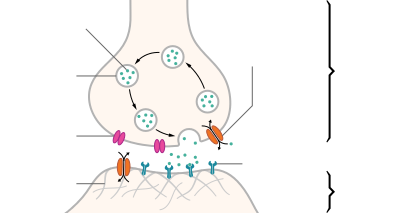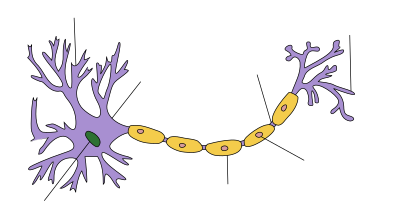Outline of the human nervous system
The following is provided as an overview of and topical guide to the human nervous system:

Human nervous system – the part of the human body that coordinates a person's voluntary and involuntary actions and transmits signals between different parts of the body. The human nervous system consists of two main parts: the central nervous system (CNS) and the peripheral nervous system (PNS). The CNS contains the brain and spinal cord. The PNS consists mainly of nerves, which are long fibers that connect the CNS to every other part of the body. The PNS includes motor neurons, mediating voluntary movement; the autonomic nervous system, comprising the sympathetic nervous system and the parasympathetic nervous system and regulating involuntary functions; and the enteric nervous system, a semi-independent part of the nervous system whose function is to control the gastrointestinal system.
Evolution of the human nervous system[]
- Evolution of nervous systems
- Evolution of human intelligence
- Evolution of the human brain
- Paleoneurology
Some branches of science that study the human nervous system[]
- Neuroscience
- Neurology
- Paleoneurology
- Neurology
Central nervous system[]
The central nervous system (CNS) is the largest part of the nervous system and includes the brain and spinal cord.
- Spinal cord
Brain[]
Brain – center of the nervous system.
- Outline of the human brain
- List of regions of the human brain
Principal regions of the vertebrate brain:

|
Brain | Forebrain | Telencephalon | Rhinencephalon, Amygdala, Hippocampus, Neocortex, Lateral ventricles, Basal ganglia | |
| Diencephalon | Epithalamus, Thalamus, Hypothalamus, Subthalamus, Pituitary gland, Pineal gland | ||||
| Midbrain | Tectum, Cerebral peduncle, Pretectum, Mesencephalic duct | ||||
| Hindbrain | Metencephalon | Pons, Cerebellum, | |||
| Myelencephalon | Medulla oblongata | ||||
Peripheral nervous system[]
Peripheral nervous system (PNS) – nervous system structures that do not lie within the CNS.
| Peripheral nervous system |
by direction | afferent system | |
| efferent system | |||
| By function | Somatic | ||
| Autonomic | Sympathetic | ||
| Parasympathetic | |||
| Enteric | |||
Sensory system[]
A sensory system is a part of the nervous system responsible for processing sensory information. A sensory system consists of sensory receptors, neural pathways, and parts of the brain involved in sensory perception.
- Sensory neuron
- Perception
- Visual system
- Auditory system
- Somatosensory system
- Vestibular system
- Olfactory system
- Taste
- Pain
Components of the nervous system[]
- Neuron
- Interneuron
- Ganglion (PNS) vs Nucleus (neuroanatomy) (CNS) except basal ganglia (CNS)
- Nerve(PNS) vs Tract (neuroanatomy) (CNS)
- White matter (more myelinated) vs Grey matter
Glial cells[]
Glial cells, commonly called neuroglia or glia, are supportive cells that maintain homeostasis, form myelin, and provide support and protection for the brain's neurons.
- Microglia
- Astrocyte
- Oligodendrocyte (CNS) vs Schwann cell (PNS)
Neuron[]
| Neuron |
|---|
A neuron (also known as a neurone or nerve cell) is an excitable cell in the nervous system that processes and transmits information by electrochemical signaling. Neurons are the core components of the brain, spinal cord, and peripheral nerves.
- Soma
- Axon
- Myelin
- Dendrite
- Dendritic spine
Action potential[]
An action potential (or nerve impulse) is a transient alteration of the transmembrane voltage (or membrane potential) across the membrane in an excitable cell generated by the activity of voltage-gated ion channels embedded in the membrane. The best known action potentials are pulse-like waves that travel along the axons of neurons.
- Membrane potential
- Ion channel
- Voltage-gated ion channels
Synapse[]
| Structure of a typical chemical synapse |
|---|

Voltage-
gated Ca++ channel Receptor
Neurotransmitter
Synaptic cleft
Dendrite |
Synapses are specialized junctions through which neurons signal to each other and to non-neuronal cells such as those in muscles or glands.
- Chemical synapse
- Gap junction
- Synaptic plasticity
- Long-term potentiation
Neurotransmitter[]
Neurotransmitter – endogenous chemical that relays, amplifies, and modulates signals between neurons and other cells to which they are synaptically connected.
- Neuromodulator
- Monoamine neurotransmitter
- Neuropeptide
Neurotransmitter receptor[]
Neurotransmitter receptor – membrane receptor that can be activated by a neurotransmitter. Interactions between neurotransmitters and neurotransmitter receptors can evoke a wide range of differing responses from the cell receiving the signal, including excitation, inhibition, and various types of modulation.
- Category:Receptors
Biological neural network[]
Biological neural network – population of physically interconnected neurons that act cooperatively to form a functional circuit. Computer scientists and engineers also study artificial neural networks formed by simplified mathematical abstractions of the signaling properties of biological neurons.
- Central pattern generator
- Reflex arc
- Neural oscillations
- Neural network
Neural development[]
Neural development – comprises the processes that generate, shape, and reshape the nervous system, from the earliest stages of embryogenesis to the final years of life.
- Neural plasticity
- Neurogenesis
- Neuroregeneration
Prenatal development of the nervous system[]
Neurogenesis[]
- General neural development
- Neural crest
- Cranial neural crest
- Truncal neural crest
- Neural tube
- Rostral neuropore
- Neuromere/Rhombomere
- Cephalic flexure
- Pontine flexure
- Alar plate
- sensory
- Basal plate
- motor
- Glioblast
- Neuroblast
- Germinal matrix
Eye development[]
- Neural tube: Optic vesicle
- Optic stalk
- Optic cup
- Surface ectoderm: Lens placode
Auditory development[]
Motor control[]
Motor control – comprises the activities carried out by the nervous system that organize the musculoskeletal system to create coordinated movements and skilled actions.
- Motor system
- cerebrum
- Basal ganglia
- Reflex
Learning and memory[]
Memory – organism's ability to store, retain, and recall information. "Learning" means acquiring new knowledge, behaviors, skills, values, preferences or understanding, and may involve synthesizing different types of information.
- Amnesia
- Synaptic plasticity
- Classical conditioning
- Operant conditioning
- Imprinting (psychology)
Cognition[]
Cognition – activities involved in processing information, applying knowledge, and changing preferences. Cognition, or cognitive processes, can be natural or artificial, conscious or unconscious.
- Mind
- Consciousness
- Neural correlates of consciousness
- Attention
- Emotion
- Intelligence
- Decision-making
- Executive function
Arousal[]
Arousal – physiological and psychological state of being awake or reactive to stimuli.
- Sleep
- Anesthesia
- Coma
- Reticular formation
Anatomical structures of the human nervous system by subsystem[]
Central nervous system[]
Central nervous system
- General terms
- Meninges
- Spinal cord
- Gray columns
- White substance
- Brain
- Brainstem
- Cerebellum
- Diencephalon
- Telencephalon
Peripheral nervous system[]
Peripheral nervous system
- General termsi
- Cranial nerves
- Olfactory nerve
- Optic nerve
- Oculomotor nerve
- Trochlear nerve
- Trigeminal nerve
- Sensory root
- Ophthalmic nerve
- Maxillary nerve
- Nasopalatine nerve
- Pharyngeal nerve
- Greater palatine nerve
- Lesser palatine nerves
- Superior alveolar nerves
- Zygomatic nerve
- Infra-orbital nerve
- Mandibular nerve
- Abducent nerve
- Facial nerve
- Posterior auricular nerve
- Intermediate nerve
- Greater petrosal nerve
- Chorda tympani (also in trigeminal? redundancy?)
- Vestibulocochlear nerve
- Glossopharyngeal nerve
- Vagus nerve
- Superior laryngeal nerve
- Recurrent laryngeal nerve
- Accessory nerve
- Hypoglossal nerve
- Spinal nerves
- Cervical nerves
- Suboccipital nerve
- Greater occipital nerve
- Third occipital nerve
- Cervical plexus
- Brachial plexus
- Supraclavicular part
- Infraclavicular part
- Musculocutaneous nerve
- Medial cutaneous nerve of arm
- Medial cutaneous nerve of forearm
- Median nerve
- Ulnar nerve
- Radial nerve
- Axillary nerve
- Thoracic nerves
- Lumbar nerves
- Medial clunial nerves
- Sacral nerves and coccygeal nerve
- Lumbar plexus
- Sacral plexus
- Nerve to obturator internus
- Nerve to piriformis
- Nerve to quadratus femoris
- Superior gluteal nerve
- Inferior gluteal nerve
- Posterior cutaneous nerve of thigh
- Inferior clunial nerves
- Perforating cutaneous nerve
- Pudendal nerve
- Inferior anal nerves
- Perineal nerves
- Posterior labial nerves
- Posterior scrotal nerves
- Dorsal nerve of clitoris
- Dorsal nerve of penis
- Coccygeal nerve
- Sciatic nerve
- Cervical nerves
- Autonomic division (Autonomic nervous system)
- Sympathetic part
- Sympathetic trunk
- Rami communicantes
- Superior cervical ganglion
- Middle cervical ganglion
- Cervicothoracic ganglion (Stellate - should prob. include inferior cerv. ganglion)
- Thoracic ganglia
- Greater splanchnic nerve
- Lesser splanchnic nerve
- Least splanchnic nerve
- Lumbar ganglia
- Sacral ganglia
- Sympathetic trunk
- Parasympathetic part
- Cranial part
- Pelvic part
- Pelvic ganglia
- Parasympathetic root of pelvic ganglia = Pelvic splanchnic nerves
- Pelvic ganglia
- Peripheral autonomic plexuses and ganglia
- Craniocervical part
- Thoracic part
- Abdominal part
- Celiac plexus
- Aorticorenal ganglia
- Superior mesenteric plexus
- Inferior mesenteric plexus
- Pelvic part
- Sympathetic part
See also[]
- List of regions in the human brain
- List of nerves of the human body
- Outline of human anatomy
- Outline of neuroscience
External links[]
- Outlines of health and fitness
- Wikipedia outlines
- Human anatomy
